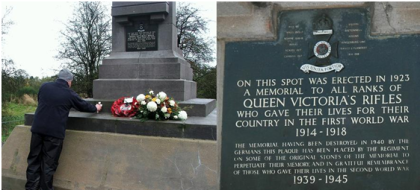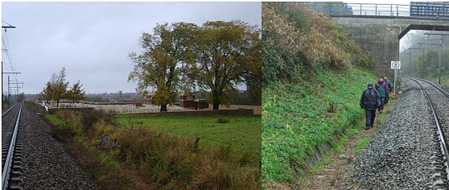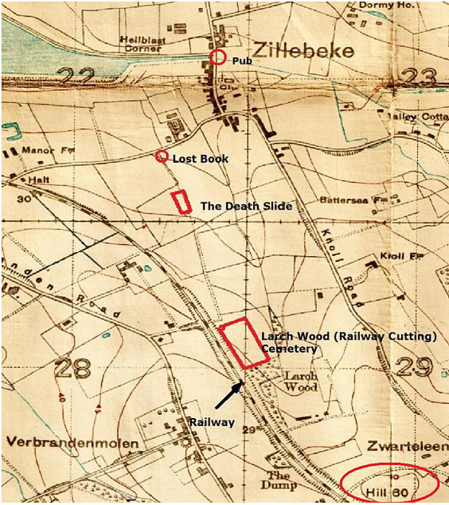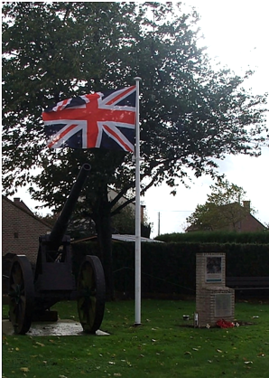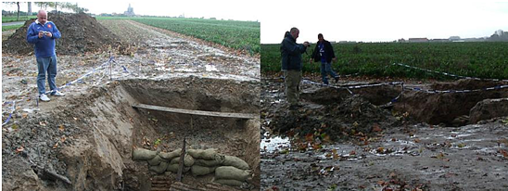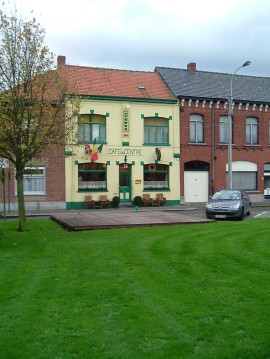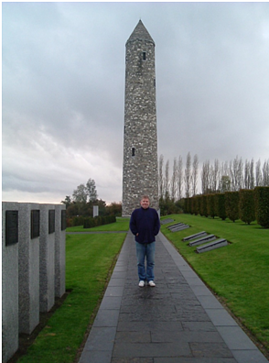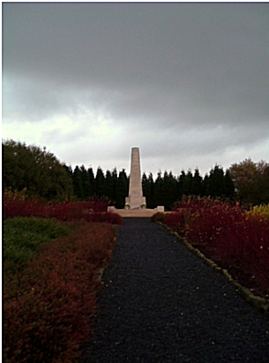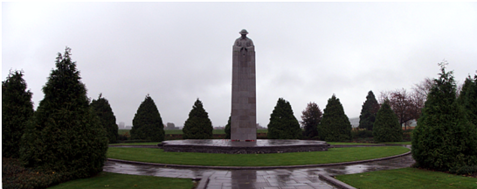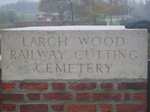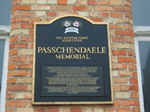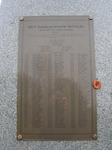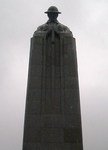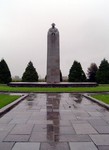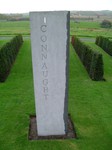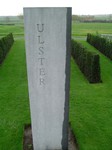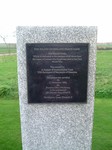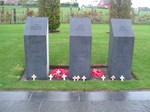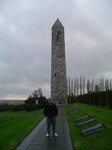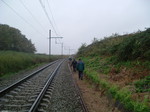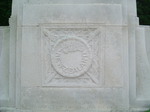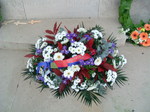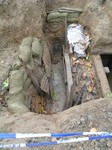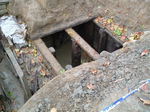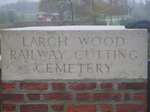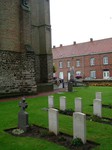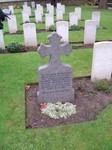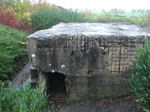
Ypres 2006
Wetness, Railways and Fresh new dugouts!
Soaked, sodden, drenched, sopping, soggy and wet are the best ways to describe the next part of our trip. It rained, boy did it rain. We were heading for Passchendaele and Passchendaele was
infamous for rain during WWI, now I am not complaining and being soaked in 2006 was a million miles from being soaked at Passchendaele in WWI, but even with us wearing water-proofs it was a torrid
day.
Our first stop was at Hill 60. In the winter of 1914-15 there was a period of “Relative quietness” in the Ypres salient but as the word implies it was “relative” and in the spring fierce
fighting took place for a 60 metre high feature to the south east of Ypres known to the British as Hill 60
In reality it was a low ridge some 150 feet high and about 250 yards from end to end. It was artificially formed when the railway cutting was dug which divided it into two distinct locations. The
Germans had captured the ridge from the French on December 10,1914 and soon after the British took over in February 1915 it was decided that this tactically significant ground had to be recaptured.
The day selected for the attack - April 17, 1915 was quiet and hot with brilliant sunshine. At 19.00. Two pairs and a single mine dug by 171 Tunnelling Coy were exploded under the hill at 10-second
intervals.
For an officer standing close to Corporal T. Newell from 171 Coy it was a grim payback. “We all just stood looking” recalled Newell “And the officer beside me, the one who'd pushed the plunger, I
heard him say, “There! That's avenged my brother” Lt J. Todd of 11th Bn Prince of Wales' Own Yorkshire Regiment recalled the seconds before the mines exploded. “It was an appalling moment. We all had
the feeling, “It's not going!” And then a most remarkable thing happened. The ground on which I was lying started to go up and down just like an earthquake. It lasted for seconds and then, suddenly
in front of us, the Hill 60 mine went up.”
Immediately, the 1st Bn. Royal West Kent Regt. and Royal Engineer (RE) Sappers charged forward. Within three minutes they had captured the crest and the engineers immediately started building field
fortifications around the lips of the craters..At around 22.00 German artillery opened fire with one stage the fire came from 54 different guns. This was followed by a counter- attack. Hand to hand
fighting took place with bayonet and bomb. Early in the morning a battalion of the Kings Own Scottish Borderers moved up to the shell pocked and cratered feature at the same time that the Germans put
in another counter-attack. By the time they were withdrawn the West Kent's had suffered 50% casualties.
In the days that followed battalions were rotated through the feature. On April 20-21 the fighting was particularly savage and it was then that four Victoria Crosses were won - Private E. Dwyer, Lt
Roupell , 2nd Lt Geary and Lt. Woolley. Woolley from 1/9th Bn London Regiment (Queen Victoria Rifles) was a Territorial Army soldier who had planned to join the Church before the war. He survived the
war and was ordained, serving as an Army Chaplain in North Africa in the Second World War. On May 1, 1915 the Germans launched another attack backed by gas.
The British battalion holding the hill on that day was the 1st Bn. Dorsets with 59 Field Coy. R.E. When the gas cleared five officers and 300 men had become casualties. Another gas attack that
followed four days later caught the 2nd Bn. Duke of Wellingtons in the trenches. The battalion was overwhelmed and the top of the hill, such as it was, was captured by the Germans and remained in
their hands with the British holding the trenches lower down.
After the war the Queen Victoria Rifles erected a monument at Hill 60. In 1940 when the area was captured by the Germans in the Second World War they destroyed it because it made reference to their
use of gas. It is now been replaced by a new one and an NMBS cross was placed upon it. Please do not laugh at my water-proof pants.
We went from Hill 60 to quickly have a look at Caterpillar Crater. Caterpillar Crater was formed by a mine exploded under the German position on high ground south of the Ypres- Comines
railway. Hill 60 and the "Caterpillar" would be the northern section of the mine battle on June 7, 1917. The Caterpillar was the name coined for the meandering hill on the south side of the railway.
On aerial photographs the shape of the hill top at this time resembled a caterpillar, hence the name.
Then with our squelching boots, onwards to Larch Wood (Railway Cutting) Cemetery, some four hundred yards west of the hill, but we had to walk down the side of a used railway to get there. This is
not the most accessible of cemeteries, I have ever been too, but as always with the CWGC one it is beautiful and dignified and the final resting place of many men who were killed in the almost
continuous fighting that took place there and around Hill 60.
The cemetery contains the graves of over 850 soldiers. Amongst these is the grave of Rifleman Clarence Eastwood Peel, who was killed in the area on 21 October 1917. Clarence Peel was the
maternal uncle of modern-day playwright Alan Bennett. Bennett has detailed his search for both the grave and the life story of his uncle in the radio monologue
"Uncle Clarence".
Leaving the cemetery we decided to walk and find a rest bite from the rain at Zillebeke, as we walked though fields we then found a track that we could see in the distance was a housing estate.
Just before this estate we got to a small play ground that had a ‘Death Slide’ on. Stuart is a legend. For on that wet, miserable day he cheered us up by going on the slide and falling
off. Stuart showed true spirit and friendship by lightening the mood of the bedraggled NMBS.
Still chuckling we find a pub and even though Belgium’s do cracking beers, on that cold, wet day it was coffees. Sitting in a pub that was almost a shrine to the Belgium 1960 and 70s cyclist,
Eddie Merckx, was a nice way to warm up and dry off a bit.
But disaster struck as Lance realised he had dropped the guide book he was using. Never seeing a man down, I left my coffee and Lance and I retraced our wet footsteps and finally found the
book, surprisingly less soggy than us. (See map)
At St. Eloi there is a crater, like the one at Hooge and The Caterpillar Crater,
There is also a small memorial and a canon. The memorial commemorates the actions of the St. Eloi craters between the 27th of March and the 16th of April 1916. One of these 1916 craters
can be seen today, although it is on private land – we just sat in the car and took pictures of the crater, well it was raining.
Six mines were exploded on the morning of March 27th - with shells from heavy howitzers being fired 20 seconds before zero hour and from heavy guns 10 seconds before, so they would land at the same
time the mines were fired. The infantry of the Third Division scrambled to occupy the craters; the 1st Northumberland Fusiliers made good progress, but on their left the 4th Royal Fusiliers were held
up by machine-gun fire. The Germans occupied two of the craters, and tried a few days later to take another from the British. On the 3rd of April, the 8th Kings Own forced the Germans out of one of
the craters, and the 2nd Canadian Division took over the positions here that night. On the 6th of April at 3.30 a.m. the Germans attacked, taking four of the craters.
The front line positions and the situation must have been incredibly complex and difficult to understand; made harder by the fact that the six new craters now made a total of 17 in the area, and
telling them apart especially in the dark must have been nearly impossible. The Canadians made several attacks over the next few days to try and recover some of the craters, but these failed, and in
view of the forthcoming major operations on the Somme no further offensive moves were made here.
On the lower part of the memorial is a poem by Thomas Hulme, titled 'Trenches of St-Eloi'. The memorial was unveiled on the 11th of November 2001. Next to it when I last visited was a small wooden
stand, in memory of Private Joseph Toms of the 12th East Surreys, with pictures of him both in uniform and with his family. Toms died near here in April 1917, although the CWGC gives his date of
death as the 3rd of May. He was from Epsom, and was just 20 when he died. He has no known grave, and is commemorated on the Menin Gate.
After this we were hungry and found,
would you believe an Irish pub. The pub is called ‘The Tower’ (pictured below) and its address is Mesen Markt 23, 8957. I give it publicity for a number of reasons, the Guinness was good, the food
was hot and they told us about a new trench system that very few had seen before – basically because it was underground and a farmer’s tractor had fell through it the day before.
The Tower is so named after the Island of Ireland Peace Park and its surrounding park (Páirc Síochána d'Oileán na h'Éireann), a beautiful memorial to the soldiers of the of Ireland
who died, were wounded or are missing from World War
I, during Ireland's
involvement in the conflict. The tower memorial is close
to the site of the June 1917 battle for the Messines Ridge and was chosen because that battle witnessed one of the few where Irishmen, regardless of religion, fought side by side against a common
enemy.
More soldiers from an Island fought against the Germans in this area. The New Zealand troops had to advance up a steep hill to reach Messines, from their front lines in the vicinity of the farm
buildings in the valley below. Walking up the road that curves up the hill, you realise what a steep climb this would have been for the attackers. Near the top of the hill is the New Zealand Memorial
Park.
The entrance to the New Zealand Memorial Park is semi-circular in shape, with a low hedged area. The memorial itself is a tall obelisk, similar to other New Zealand memorials on the Western Front.
The wording on the front is 'In honour of the men of the New Zealand Division. The Battle of Messines 7th to 14th of June 1917'. The memorial was unveiled by the Belgian King (Albert I) on the 1st of
August 1924.
The New Zealand Memorial Park is not the only site in the area that has a strong connection to the brave men, who crossed oceans and continents to fight in muddle battlefields in Europe for “The King
and Empire”.
The New Zealanders are also remembered at 'S Graventafel,
(Yes, that is how it is spelt and it played havoc with spell check! During the war, the ridge and village were spelt Gravenstafel). Since we last visited 'S Graventafel,
there is a memorial for the Canadians who faced the German’s first use of chlorine gas in WWI.
It was unveiled on the 24th April 2010. At around 5:00 pm on 22 April 1915, the German’s released one hundred and sixty-eight tons of chlorine gas over a 4 mile area. This was
held by French Territorial and colonial Moroccan and Algerian troops of the French 45th and 78th division. While this is often recognized as the first use of chemical warfare, poison gases were
used at several earlier battles, including the Battle of Bolimów (Between Russia and Germany in what is now Poland).
Approximately 6,000 French and colonial troops died within ten minutes at Ypres, primarily from asphyxiation and subsequent tissue damage in the lungs. Many more were blinded. Chlorine gas forms
hypochloric acid when combined with water, destroying moist tissues such as lungs and eyes. The chlorine gas, being denser than air, quickly filled the trenches, forcing the troops to climb out
into heavy enemy fire. Canadian troops were able to put in a hasty defence by urinating into cloths and putting them to their faces to counter the effects of the gas.
Canadians held that part of the line against further attacks until 3 May 1915 at a cost of 6,000 wounded or dead. Casualties were especially heavy for the 13th Battalion of the CEF, which was
enveloped on three sides and over-extended by the demands of securing its left flank once the Algerian Division had broken. One thousand of these "original" troops were killed and 4,975 were wounded
from an initial strength of 10,000.
Today the sombre, but impressive “Brooding Soldier” Memorial at St. Julien Memorial is a testament to the Canadians. The memorial commemorates the Canadian First Division’s participation
in the Second Battle of Ypres. (Including the defence against the first poison gas attacks)
Frederick Chapman Clemesha's sculpture, the Brooding Soldier, was selected to serve as the central feature of the monument following a design competition organized by the Canadian Battlefield
Monument Commission in 1920
